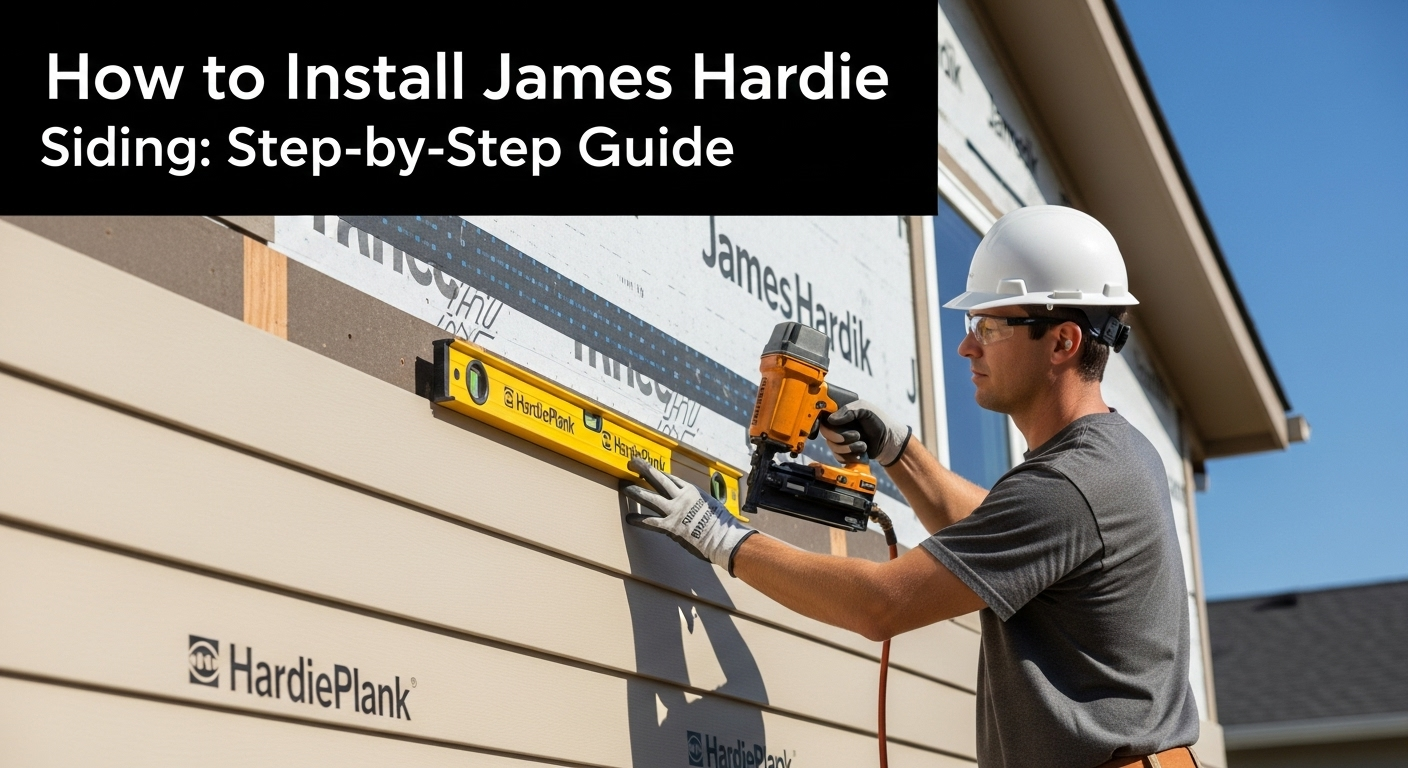Preparing for Your James Hardie Siding Installation
Before a single plank is installed, thorough preparation is paramount. This initial phase involves gathering the right equipment, materials, and understanding safety protocols. Proper prep work prevents common installation errors and ensures a smooth workflow.
A well-organized project begins long before the first cut. Taking the time to prepare the worksite and the wall an itself sets the stage for a professional-quality result. This attention to detail is a critical aspect of how to install James Hardie siding.

Essential Tools and Materials
Having the correct tools and materials on hand is non-negotiable for a successful fiber cement siding project. The unique composition of the material requires specific equipment for cutting and fastening. Attempting the job with standard woodworking tools can lead to poor results and safety hazards.
Required Tools
Gathering your tools ahead of time will prevent delays during the installation. You will need a circular saw or miter saw equipped with a specialty fiber cement blade, often called a HardieBlade. For cleaner, less dusty cuts, consider using pneumatic or electric fiber cement shears. Additional essential tools include a siding nail gun, a level, a chalk line, a tape measure, and sawhorses.
Necessary Materials
Your material list extends beyond the HardiePlank siding itself. You will also need corrosion-resistant siding nails or screws appropriate for your framing type. Other crucial materials include a starter strip, weather-resistant barrier (house wrap), appropriate flashing, and trim boards for corners and windows. Finally, be sure to have paintable, high-quality exterior caulk for sealing gaps.
Safety First: Personal Protective Equipment (PPE)
Safety is the most important part of any guide on how to install James Hardie siding. Cutting fiber cement siding generates respirable crystalline silica dust, which is a health hazard if inhaled. Always wear a NIOSH-approved N95 respirator or a higher-rated mask when cutting.
In addition to respiratory protection, safety glasses are mandatory to protect your eyes from dust and debris. Wearing durable work gloves will protect your hands from abrasion while handling the planks. Prioritizing safety ensures the project is completed without injury.
The Complete Installation Process
With preparation complete, the installation can begin. This process is methodical, starting with the wall preparation and moving through cutting, fastening, and installing each course of siding. Patience and precision are key to achieving a flawless finish that looks great and performs well.
Preparing the Wall Surface
The first step is to create a clean, flat, and waterproof surface for the siding. Start by removing any existing siding and inspecting the sheathing underneath for damage or rot, making repairs as needed. A proper guide on how to install James Hardie siding always emphasizes a solid substrate.
Next, install a high-quality, water-resistive barrier (WRB), or house wrap, over the entire wall surface. Overlap the seams according to the manufacturer’s instructions and seal them with approved tape. This WRB is your home’s primary defense against moisture intrusion.
Properly flash all windows, doors, and other wall penetrations. This step is critical for preventing water from getting behind the siding and causing damage to your home’s structure. Correct flashing is a cornerstone of professional siding installation.
Cutting and Handling HardiePlank Siding
Handling and cutting fiber cement requires specific techniques. The planks can be brittle, so they should be carried on edge and supported properly to prevent them from snapping. When storing planks on-site, keep them flat, dry, and off the ground.
Cutting Techniques
The best method for cutting HardiePlank siding depends greatly on the type of tools available, the size and complexity of your project, and your tolerance for dust and debris. Because HardiePlank is a fiber cement material, it is denser and more brittle than wood, which means choosing the right cutting technique is crucial to achieving clean, accurate cuts while minimizing health risks and material waste.
Using fiber cement shears is widely regarded as the cleanest and most efficient method. These specialized shears are designed specifically for fiber cement materials and operate with a slow, scissor-like cutting motion that minimizes the release of airborne dust particles. This makes them ideal for indoor or enclosed workspaces where ventilation is limited. They also produce a smooth, consistent edge that requires little to no sanding afterward. However, while fiber cement shears are excellent for straight or slightly curved cuts, they may not be suitable for tight corners or intricate shapes due to their limited maneuverability.
Alternatively, a circular saw equipped with a fiber cement blade—often featuring polycrystalline diamond-tipped or carbide-tipped teeth—provides a faster and more powerful cutting option, especially for larger jobs or when multiple boards must be cut quickly. However, this method generates a significant amount of respirable crystalline silica dust, which can pose serious health risks such as silicosis if inhaled. Therefore, when using a circular saw, it is absolutely essential to work in a well-ventilated area, preferably outdoors, and to use proper dust control measures such as a vacuum attachment or dust shroud. Workers should always wear appropriate personal protective equipment (PPE), including a NIOSH-approved respirator, safety goggles, hearing protection, and gloves to reduce the risk of injury or exposure.
For smaller or more detailed cuts—such as creating notches around windows, doors, vents, or electrical outlets—the score-and-snap method is an effective, low-dust alternative. This technique involves using a carbide-tipped scoring tool to score along a straight line on the face of the board, then applying gentle pressure to snap the board cleanly along the scored line. Although this approach requires more manual effort and precision, it produces minimal dust and is ideal for small adjustments or when working indoors without power tools.
Regardless of which cutting method is chosen, it is important to support the material properly throughout the cutting process to prevent cracking or splintering, especially near edges. Always measure and mark your cuts carefully using a straight edge or T-square, and double-check your measurements before cutting to reduce waste. After cutting, lightly sand any rough edges with fine-grit sandpaper to create a smooth, professional finish that is ready for painting or installation.
In summary, the key to successful HardiePlank cutting lies in balancing efficiency, accuracy, and safety. Fiber cement shears provide a clean, low-dust option; circular saws offer speed and power but require strict dust control; and the score-and-snap method delivers precision with minimal airborne particles. Choosing the right method based on your workspace, tools, and project scale will ensure high-quality results and a safer working environment
Handling and Fastening
Correct fastening is fundamental to understanding how to install James Hardie siding. Use only corrosion-resistant fasteners, such as hot-dipped galvanized nails or stainless steel nails. The two primary methods are blind nailing and face nailing, with blind nailing being the more common and aesthetically pleasing option for most plank installations.
For blind nailing, drive the fastener through the top of the plank, about 1 inch down from the top edge. The subsequent course of siding will cover this nail head. Ensure the nails penetrate at least 1 inch into solid wood studs or sheathing. Do not overdrive the nails; the nail head should be snug against the siding surface, not breaking its face.
Installing the Siding Planks
With the walls prepared and the techniques mastered, it’s time to begin the core of the installation. This section covers the step-by-step process of applying the siding, from the starter strip to the final plank. This phase of how to install James Hardie siding is where your home’s new look truly takes shape.
First, install a metal or PVC starter strip along the bottom edge of the wall where the siding will begin. This strip kicks out the bottom of the first course, ensuring it has the same angle as the subsequent overlapping courses. Use a level and chalk line to ensure the starter strip is perfectly straight.
Next, install your corner trim and the trim around windows and doors. The siding planks will butt up against this trim. Remember to leave a 1/8-inch gap between the siding plank and the trim, which will later be filled with caulk.
Now you can install the first course of siding, resting it on the starter strip. Ensure this first course is perfectly level, as any error here will be magnified as you move up the wall. This is one of the most important steps in any tutorial on how to install James Hardie siding.
For subsequent courses, use a siding gauge or a scrap piece of siding to maintain a consistent overlap, which is typically 1-1/4 inches. Stagger the butt joints between planks from one course to the next, ensuring they do not align vertically. This staggered pattern is crucial for both structural integrity and visual appeal.
Butt joints should always land on a stud. Place a small piece of flashing behind each butt joint to manage any water that might penetrate the seam. As you work your way up the wall, check for level every few courses to ensure everything remains straight. The core of learning how to install James Hardie siding is about consistency and precision.

Finishing Touches and Final Checks
The final phase involves sealing, painting, and cleaning up the worksite. These finishing touches are what separate an amateur job from a professional one. A meticulous finish ensures your siding is weatherproof and looks its best.
Apply a high-quality, paintable exterior-grade caulk to all required gaps. This includes the 1/8-inch gap left between the siding planks and the vertical trim pieces. Do not caulk the bottom horizontal edge of the planks, as this allows any trapped moisture to escape.
If you are using James Hardie’s pre-primed siding (PrimePlus), it must be painted within 180 days of installation. Use a 100% acrylic exterior-grade paint for the best results, following the paint manufacturer’s application instructions. For ColorPlus products, simply touch up any exposed cut edges or nail heads with the provided touch-up paint.
Once painting and caulking are complete, conduct a final inspection of the entire job. Look for any imperfections, uncaulked gaps, or areas that need a paint touch-up. A thorough final check is the last step in how to install James Hardie siding properly.
Finally, clean the worksite thoroughly. Remove all siding scraps, dust, and debris. A clean site is the sign of a job well done.
Conclusion: A Durable and Beautiful Exterior
By following this guide, you have learned the essential steps and techniques for how to install James Hardie siding. From meticulous preparation and safety precautions to precise cutting and fastening, each step is crucial for a successful outcome. The process requires patience, the right tools, and a commitment to quality craftsmanship.
Properly installed James Hardie siding will protect and beautify your home for many years, offering a fantastic return on investment. Whether you tackle this as a DIY project or oversee a professional crew, understanding the fundamentals of how to install James Hardie siding empowers you to achieve the best possible result. Your home will now stand protected by one of the most durable and reliable siding products on the market.






